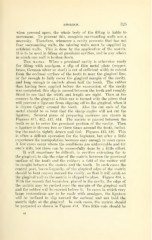Page 663 - My FlipBook
P. 663
AMALGAM. 325
when pressed upon, the whole body of the filling is liable to
movement. To prevent this, complete surrounding walls are a
necessity. Therefore, whenever a cavity presents that has not
four surrounding walls, the missing walls must be supplied by
artificial walls. This is done by the application of the matrix.
It is to be used in filling all proximal cavities, and in any others
in which one wall is broken down.
The matrix. When a proximal cavity is otherwise ready
for filling with amalgam, a slip of thin metal plate (copper,
brass, German silver or steel) is cut of sufficient width to extend
from the occlusal surface of the tooth to near the gingival line,
or far enough to fully cover the gingival margin of the cavity,
and long enough to encircle about half the tooth. The rubber
dam having been applied before the excavation of the cavity
was completed, this slip is passed between the teeth and roughly
fitted to see that the width and length are right. Then at the
corners to the gingival a little ear is turned with the pliers that
will prevent a ligature from slipping off to the gingival, when it
is drawn tightly around the tooth. Also the cut ends of the
metal should be so bent that the sharp angles will not cut the
ligature. Several plans of preparing matrices are shown in
Figures 411, 412, 413, 414. The matrix is passed between the
teeth so as to cover the proximal portion of the cavity. Then
a ligature is thrown two or three times around the tooth, includ-
ing the matrix, tightly drawn and tied. Figures 415, 416. This
is often a difficult operation for the beginner, but after a little
experience the manipulation becomes easy enough in most cases.
A few cases occur where the conditions are unfavorable and try
one's wits, but these can be sviccessfully done by a little effort.
It will sometimes be difficult, in cavities extending far to
the gingival, to slip the edge of the matrix between the proximal
surface of the tooth and the rubber; a fold of the rubber will
be caught between the matrix and the tooth. In such cases the
central part, bucco-lingually, of the gingival edge of the matrix
should be bent convex toward the cavity, so that it will catch on
the gingival wall as the matrix is slipped to place. Figure 414, d.
With the smooth flat burnisher, placed in the cavity, the edge of
the matrix may be pushed over the margin of the gingival wall
and the rubber will be carried before it. In cases in which very
large restorations are to be made with amalgam, the ligature
will be inclined to slip toward the occlusal and not hold the
matrix tight at the gingival. In such cases, the matrix should
be prepared as shown in Figure 414. Two little cuts should be
43


